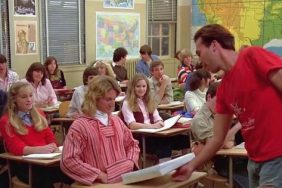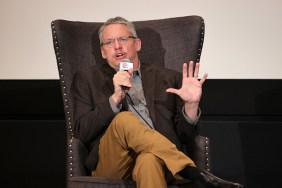
Let’s look at a few examples of the films-as-voyeurism phenomenon:
Often called the first slasher movie, Alfred Hitchcock’s 1960 masterpiece Psycho was most certainly one of the first mainstream studio films to feature such obvious examples of voyeurism. Norman Bates (Anthony Perkins) peers through a hole in a wall on Marion (Janet Leigh) as she undresses to take a shower. There is most certainly a sexual undertone to the scene, one that was made overtly sexual in the 1998 remake. But we’re not just looking at a guy look through a hole in a wall. We’re looking through the hole as well; there is a POV shot for us. In that moment, we are inside Norman Bates’ eyeball, and we are forced to become the pervy peeping tom that he is. Hitchcock used this short scene to implicate the audience in their voyeurism. We are spying on a woman undressing, and we have become the watcher. We may become aware of ourselves in the theater at that moment.
Also at the vanguard of the slasher movement was 1960’s Peeping Tom, an excellent horror movie about a serial killer (Carl Boehm) who murders women with his camera’s tripod while filming them. Surely I don’t need to point out the voyeuristic interplay going on there. Watching a movie about a man making a movie of someone dying makes us a little complicit in his homemade snuff films, doesn’t it? It breaks the “fourth wall,” calling to attention the divide between the glorious on-screen violence we so often consume, and it’s real-life counterpart.
And speaking of implicating the audience, no filmmaker has been better at that than Austria’s Michael Haneke. In both 1997 and 2007, Haneke made two versions of his movie Funny Games, a gut-wrenchingly violent home invasion flick. Two white-clad boys break into a rich family’s home to psychologically and physically torture them, perhaps on their way to murdering them. There is a very telling scene near the end of the film which I am going to give away. SPOILERS AHEAD. In both versions of the movie, the captured wife eventually breaks free from their grasp, grabs a shotgun and kills one of the torturers. It’s meant to be a moment of catharsis. Violent revenge on the criminals.

Haneke, however, doesn’t let us have that catharsis for long. The other torturer picks up a remote control, pushes “rewind,” and rewinds the very film we’re watching! He backs up past the point where his peer was murdered, and then the film begins again, this time without the torturer being murdered. Haneke is clearly trying to make the audience feel bad for wanting that violence. All violence, even cathartic revenge, is ugly and will provide you with nothing. He is implicating you for wanting to see that. He gives it to you, and then takes it away, leaving you to look at yourself and your ugly need for revenge. Thanks a lot Haneke. Your brilliant movie made me feel awful.
Haneke explores further in his movie Caché from 2005. In that film, a man begins receiving anonymous videotapes in the mail. The tapes are nothing but static shots of his home, his work, places he’s been. He begins to behave differently. By being filmed, by being watched, his own view of himself changes, and his behavior is altered. How altered? Well dark secrets are told just through self-awareness. Who is watching him? We are.

Some movies, though, are a little more playful about the voyeurism concept. 2012’s sleeper hit The Cabin in the Woods is a movie about a group of mysterious engineers who are orchestrating and manipulating the lives of a group of college kids so that it more closely resembles a boring slasher movie. The engineers are the main characters, but eventually the college kids eventually catch wise to the horror movie situation they’re in and go to investigate why they are acting like they’re in a horror movie. It’s a self-reflexive little trifle that brings a fun “Twilight Zone” element to the act of watching horror movies. Who is this “movie” being made for? Evil sacrifice hungry deities, of course? But the evil sacrifice-hungry deities is us!
And pushing the comedy element even further, we have some rather hilarious slapstick comedies that often call attention to themselves as movies. The 1984 Zucker-Abarahams-Zucker comedy Top Secret! (easily one of my favorite comedies) has a scene wherein the character recount the plot they’ve been enacting in a very obvious expository fashion. One of them posits that it sounds like a bad movie. The characters then cautiously glance at the camera. Comedy gold, and voyeurism exposed. Other comedies do similar things. Watch Mel Brooks‘ 1987 spoof Spaceballs sometime, wherein characters address the camera and ask things like “What the Hell am I looking at? When does this happen in the movie?” Brooks pulled similar stunts in Robin Hood: Men in Tights, Blazing Saddles, and most of his other movies come to think of it.

So the next time you watch a movie, try to think about the part you yourself are playing in it, you filthy little peeping tom. Try to keep an eye on the act of watching. It’s hard to do sometimes, but it’s always there.
Homework for the Week:
What movies made you aware of yourself as an audience member? Do you feel awkward or empowered by the reminder? How much does voyeurism play into art consumption? Are all movies exploitative?
Witney Seibold is a featured contributor on the CraveOnline Film Channel, and co-host of The B-Movies Podcast. You can read his weekly articles Trolling, Free Film School and The Series Project, and follow him on “Twitter” at @WitneySeibold, where he is slowly losing his mind.






